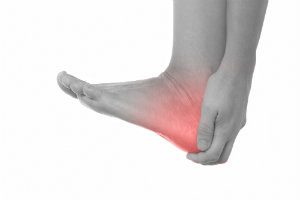Building Heel Spurs
Breaking Down PainKids are fascinated by scabs—no matter what their age. Admit it: even adults will pick at them and tear them away from a healing sore or insect bite. Part of the reason is that we don’t like to feel that hard bump of dead, dry tissue on our otherwise smooth skin. We could think of a heel spur as a sort of “bone scab.” Just as your skin forms a covering to protect damage to the underlying tissues, your body forms these projections in areas of stress to the bone tissue.
Same Problem—Different Reasons

- Plantar fasciitis – This is an inflammation of the strong ligament under your foot that supports your arch. The plantar fascia attaches each of your toes to the front underside of your heel and acts rather like a bowstring to form your foot arch. Overuse, having flat feet or high arches, and biomechanical abnormalities can put too much stress on the strong band of tissue. It can pull too hard against the heel bone and tear away a bit of the lining. Your body responds by building an extra layer of calcium at the spot to restore the bone. When this happens repeatedly, the calcium deposits form a spur that grows toward the front of the foot, in order to relieve some of the tension on the fascia.
- Achilles tendinitis – The principle is the same, but this time it is the Achilles tendon that is pulling against the back of the calcaneus where it attaches. Too-tight calf muscles or repeated stress from physical activity can cause the bone lining to pull away and your body deposits extra calcium at that spot to relieve the stress. The strong tendon can become inflamed or start to degenerate and become uncomfortable. The spur can also cause pain when it irritates the fluid sac (bursa) that cushions between tendon and heel bone.
- Haglund’s deformity – This time, the stress on your bone tissue is caused by friction from shoes—specifically those with high, curved, and rigid backs, such as ladies’ pumps, men’s dress shoes, or some skating or skiing boots. Just like a scab on a sore, the bone builds up extra layers of calcium to protect itself from the rubbing, and you end up with a visible, swollen, painful bump at the back of your heel.
Treating Heel Pain and Spurs
Spurs are typically not painful themselves. Rather, the pain is felt in the surrounding soft tissues that are irritated or injured. Removing the spur might not even help your pain as long as the other conditions are not addressed.
Plantar fasciitis and Achilles tendinitis often respond well to various conservative treatments such as changing shoes, taping or strapping, and custom orthotics. Massage, icing, pain relievers and other forms of physical therapy like stretching and strengthening exercises may also help. Haglund’s deformity pain usually gets better when you stop wearing the offending footwear.
In some cases, when several months of treatment have still not taken care of the problem, it may be advisable to remove heel spurs surgically. This is a relatively easy surgery.
Keeping Heel Spurs Away
To prevent the growth from happening in the first place, make wise shoe choices. Footwear should fit well, absorb shock to your soles, support your arch, and not pinch at your heel. It should also be appropriate for the activity you are doing, and you should replace shoes when they show signs of wear.
Other good habits include maintaining a healthy weight, warming up and stretching before and after activity, and not overworking your feet and ankles when exercising or playing sports.
Heel pain Help in Southern California
When you first notice heel pain, that’s the time to call for help. Don’t wait for a problem to become severe, when conservative treatment is less effective. Let the experts at Southern California Foot & Ankle Specialists get a handle on what’s causing your difficulties and start treatment early to avoid more serious issues. You can reach our Ladera Ranch office by calling (949) 364-9255 (WALK) or schedule using our online form. We’re here to help your feet stay healthy!
Contact Us
Ladera Ranch
333 Corporate Dr. Ste 230, Ladera Ranch, CA 92694
Tel: (949) 364-9255 (WALK)
Fax: (949) 364-9250
Office Hours:
Monday - Friday: 9am - 5pm
*(Lunch 12 noon - 1pm)
Orange
2617 E Chapman Ave. Ste 303, Orange, CA 92869
Tel: (714) 639-7993
Fax: (714) 639-0729
Office Hours:
Monday - Friday: 9am - 5pm
*(Lunch 12 noon - 1pm)
